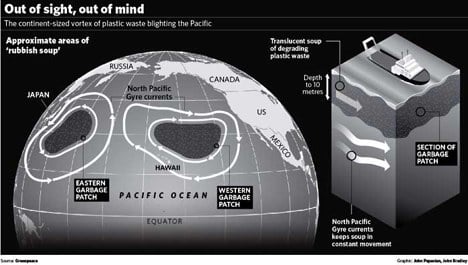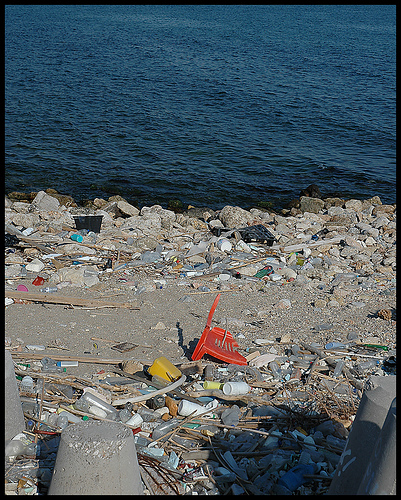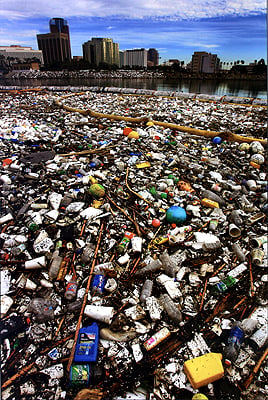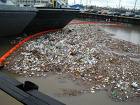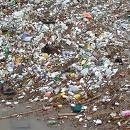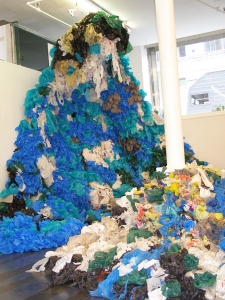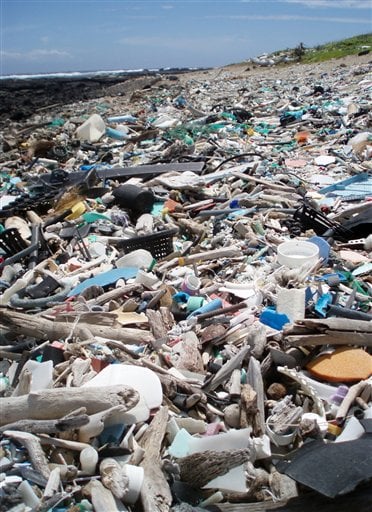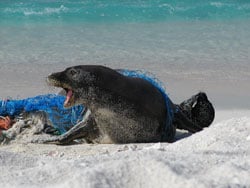| Line 23: | Line 23: | ||
[[Image:images2.jpeg]] [[Image:images4.jpeg]] [[Image:images.jpeg]][[Image:images8.jpeg]] [[Image:images7.jpeg]] [[Image:images9.jpeg]] | [[Image:images2.jpeg]] [[Image:images4.jpeg]] [[Image:images.jpeg]][[Image:images8.jpeg]] [[Image:images7.jpeg]] [[Image:images9.jpeg]] | ||
Composition of marine garbage/plastics varies from area to area. Although a general trend seems to be that 80% of the marine trash comes from land, storms wash garbage off highways and city streets, down streams and rivers, and out to sea. The rest come from ships, cruise lines that illegally dump their waste, oil platforms, or fishing boats. "In addition, thousands of cargo containers fall overboard in stormy seas each year, spilling their contents. One ship heading from Los Angeles to Tacoma, Wash., disgorged 33,000 blue-and-white Nike basketball shoes in 2002. Other loads lost at sea include 34,000 hockey gloves and 29,000 yellow rubber ducks and other bathtub toys." | |||
Consumer Societies: | |||
Between 1960 and 2007 US waste generation nearly doubled from 2.68 to 4.63#/person (Moore, 2011). | |||
== What kind of stuff can be found in Garbage Patches? == | == What kind of stuff can be found in Garbage Patches? == | ||
Revision as of 21:45, 29 January 2012
“I was confronted, as far as the eye could see, with the sight of plastic. It seemed unbelievable, but I never found a clear spot. In the week it took to cross the subtropical high, no matter what time of day I looked, plastic debris was floating everywhere.” Moore
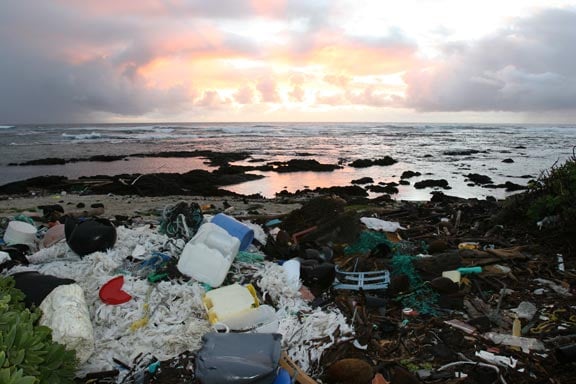
In 1997, [Charles Moore] navigated an alternate route from Hawaii to Santa Barbara. He was shocked to have found debris floating in the ocean about 1000 miles north of Hawaii and 1000 miles West of San Francisco. The more he looked, the more he found, the more he found, the more disturbed he became. He founded The [Algalita Marine Research Foundation] to address this phenomenon as well as the global issue of plastic pollution.
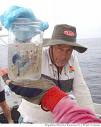
What is the Garbage Patch?
The "Garbage Patch" is a term coined by Curtis Ebbesmeyer; it refers to the world's largest landfill that has been infiltrating the Pacific Ocean. It consists of all sorts of trash from all over the world, 90% of it being plastic. Many people wrongly believe that it is a solid land form, but it isn't, most of it can't even been seen above the water. It is billions upon billions of tiny pieces of plastic and debris that outnumber the plankton 10:1 as well as larger pieces of floating plastics and derelict fishing gear. So for every pound of plankton, there are ten pounds of little pieces of plastic.
Where is it located?
The Garbage Patch is located in the Pacific Ocean. The Eastern Garbage Patch is located between Japan and Hawaii. The Western Garbage Patch is located between Hawaii and the US. The Western Patch is approximately twice the size of Texas. The Eastern and Western patches combined is thought to be two times the size of the continental US and is estimated to be 10 to 30 meters deep. The Global Ocean has at least eight major garbage patches (housed within each of the eight subtropical gyres). Our oceans (and watersheds) are replete with plastics.
Where does this garbage come from?
Composition of marine garbage/plastics varies from area to area. Although a general trend seems to be that 80% of the marine trash comes from land, storms wash garbage off highways and city streets, down streams and rivers, and out to sea. The rest come from ships, cruise lines that illegally dump their waste, oil platforms, or fishing boats. "In addition, thousands of cargo containers fall overboard in stormy seas each year, spilling their contents. One ship heading from Los Angeles to Tacoma, Wash., disgorged 33,000 blue-and-white Nike basketball shoes in 2002. Other loads lost at sea include 34,000 hockey gloves and 29,000 yellow rubber ducks and other bathtub toys."
Consumer Societies: Between 1960 and 2007 US waste generation nearly doubled from 2.68 to 4.63#/person (Moore, 2011).
What kind of stuff can be found in Garbage Patches?
Baby bottles, water bottles, fishing gear, lighters, lids, rubber ducks, netting, shampoo and conditioner bottles, laundry soap bottles, milk jugs, ab rollers, happy meal toys, beer coolers, Tupperware, Swiffers, milk crates, Astroturf, hair dryers, baby pools, buckets, toothbrushes, tampon applicators, saran wrap, plastic bags, Lego's, Velcro, credit cards, breast implants, galoshes, prosthetic limbs, Styrofoam containers, contact lenses, helmets, cutlery, pens, pantyhose, condoms, dolls, flowers, photo frames, CD and DVD cases, water guns, shoes, cups, plates, pink flamingos, silly putty, sports balls, glue sticks, air conditioners, catheters, polar fleece, garden hoses, sex toys, expandable insulation, sprinklers, eyeglasses, syringes, dental floss, beach balls, fridge doors, carrier bags of all sorts = dry cleaning, fast food, grocery, wardrobe and garbage bags, hula hoops, Plexiglas police shields, carpeting, humidifiers, car bumpers, green bins, Teflon pans, Frisbees
Plastic: A Trojan Horse
Plastics are a recent development in human history, dating back to the mid to late 1800s with Alexander Parke’s synthesis of a cellulose-derived material called Parkesine (or celluloid). In 1909 Leo Hendrik Baekeland, a Belgian-born American chemist, created the first completely synthetic plastic. He combined mixtures of phenol (C6H5OH), originating from coal tar, and formaldehyde (HCOH). Under heat this substance was uniform and sticky, yet upon cooling it became extremely hard, capable of withstanding wear and tear and resisting decay. This new category of materials came to be known as “plastics” (a term coined by Baekeland). Since that time plastic science has evolved steadily, streaming from the advent of nylons to the more recent developments of liquid crystal and conductive polymers. Plastics have become the material panacea for the manufactured products of consumer societies. From their humble beginnings in 1868 as a replacement for ivory in the production of billiard balls, plastics have come to reign over an ever-expanding range of consumer goods. After World War I with the use of petroleum and improvements in chemical technology there had been a virtual plastics explosion. By the 1960s plastics ‘were within everyone's reach due to their inexpensive cost. Plastics had thus come to be considered “common” - a symbol of the consumer society (www.americanchemistry.com).’
Plastics are globally permeant, inundating our households, landfills, open spaces, waterways, and seas. This large class of substances owes its success to their relatively inexpensive manufacture and to their versatility. Physical attributes such as durability, chemical resistance, water-insolubility, and their capacity to be molded, extruded, cast, or drawn into filaments have helped to insure the steady dilation of their manufactured applications. The very same attributes, that have enabled plastics to dominate fabricated goods, are radical to the accumulation of plastics within virtually every niche on our planet. It is unknown whether plastics ever fully decompose. Plastic biodegrades very slowly (and it needs specific conditions to do this; marine environments do not provide especially compatible conditions for biodegradation of plastics). Over time they photo degrade and break down into smaller and smaller pieces yet these fragments retain their basic chemical structure. As plastics photo degrade they leach toxic chemicals including but not limited to lead, cadmium, mercury, chlorine, phthalates, and bisphenol-A. These chemical additives are used as hardeners, softeners, stabilizers, and various other ‘plasticizers’ in the plastic production process. It is estimated that additives represent approximately fifty percent of plastics by weight (Moore, 132). Halogenated organic compounds (HOCs) include legacy pollutants such as DDT and PCBs; HOC's are persistent, stable, readily absorbed but not metabolized, accumulating in fatty and liver tissues (bio-accumulative). In addition to the toxins that plastics donate to the marine environment, they also serve as a substrate on which various toxicants chemically raft. Insolubility to water is a quality, which allows plastic debris to attract and accumulate hydrophobic organic toxins up to one hundred thousand to a million times that of ambient seawater (Mato et. al., 2001).
Burgeoning populations infected by an ethos of disposability coupled with plastics’ relative indestructibility have helped to catalyze a plastic pollution crisis. Waste and pollution are cancers of consumer societies, and disposable consumer cultures have been metastasizing globally in pandemic proportions.
Conservative expense of manufacture, rampant deficiencies in government regulation, and their amorphous nature have granted plastics their ascendancy amid disposable societies. Plastics’ dominion within the waste culture poses pernicious threats to ecosystems and their inhabitants. Aided by gravity, plastics have been running downstream and downhill, concentrating in our oceans and throughout the food web (including us).
Plastic Facts
-Plastic lasts for 400 – 1000 years (supposedly)
-We use 20 times more plastic today than we did 50 years ago
-There are 60,000 plastic bags used in the US every 5 seconds
-There are 2 million plastic beverage bottles used in the US every 5 minutes
-Globally we produce ~200 million tons/year
-Less than 3.5% of which gets recycled
-Math? that’s only 7 million tons of 200 million tons that gets recycled!
-On average – we throw away ~185 lbs of plastic/ person/ year
-The U.N. Environment Program estimates that 46,000 pieces of plastic litter are floating on every square mile of the oceans. About 70% will eventually sink
Toxins Plastic is a toxic sponge, meaning that it soaks up all the hydrophobic chemicals around it. These tiny pieces of plastic concentrate the toxins, up to 1 million times more toxic than the surrounding water. Some of the toxins found have been: DDT, DDE, Hydrocarbons, PCB, PFOA, PBDE’s, POP’s and Bisphenol A; all of which are known carcinogens that cause: cancer, obesity, diabetes, infertility, neurological disorders among other things. We eat these toxins every time we eat from the ocean. Small fish eat these 'toxic pills', and bigger fish eat the small fish, and an even bigger fish eats that fish, so on and so forth, until it reaches our dinner table. The problem with some of these toxins, is that they bioaccumulate; they start out small but grow in intensity (toxicity) at every subsequent level.
Plastics equally attract toxic materials from surrounding seawater/environment as well as release toxic additives from their manufacture (these chemicals are broadly known as "plasticizers" and can make up 50% of plastics' weight).

